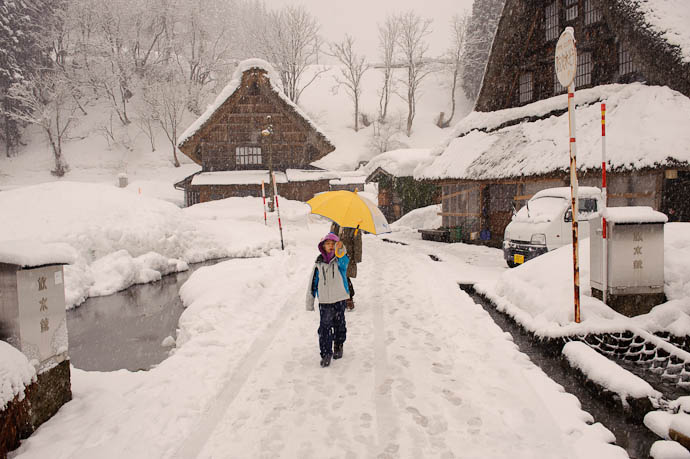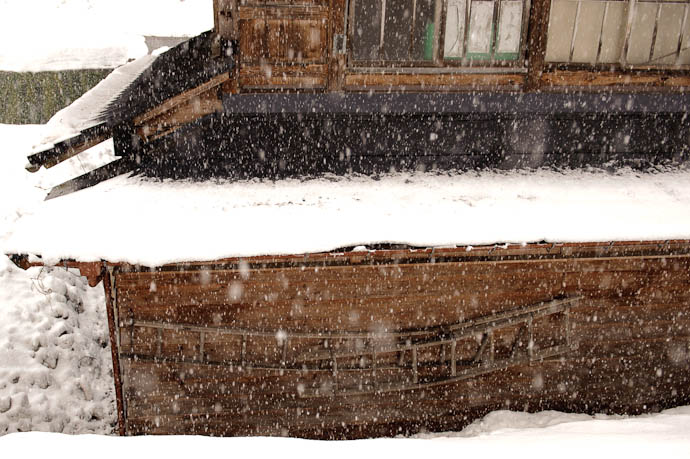One of the photos I posted in yesterday's introduction to Gokayama Village in Toyama Prefecture, Japan, was this one of Anthony and Fumie walking down one of the streets...

Nikon D700 + Nikkor 24-70mm f/2.8 @ 28 mm — 1/200 sec, f/6.3, ISO 200 — map & image data — nearby photos
Street in Gokayama
Revisited
I pointed out the silver boxes on either side of the road and in the background contain powerful water guns, on hand for fire prevention.
It's not possible to overstate how deeply rooted the fear and respect of fire is ingrained into Japanese culture. Especially for the first couple of thousand years of modern Japanese civilization, the safety of one's house and family was directly related to the fire-prevention habits of everyone else nearby, because if one house caught fire, it would spread to all houses in the area. (Until recently... until maybe 30 or 40 years ago... the vast majority of Japanese buildings were made mostly of wood.) If you made a mistake, thousands would pay, and vice-versa. Despite this ingrained caution, mass conflagrations were apparently common, so the fear was well founded.
The direct fear of mass conflagration is much less now, of course, but you can still see the deep-rooted cultural fear/respect in daily life, from 「火の用心」 (hinoyoujin, “be alert/cautious for fire”) printed on signs and the sides of buildings all over, to buckets of water still kept at the ready outside many people's houses. Still today on summer evenings, it's not uncommon to hear the resonate sound of someone hitting two thick wood batons together in cadence with a chanted “火の用心”, as a general reminder (during the evening cooking hour, since until recently cooking was always done over a fire?) to be vigilant against fires.
It can even be seen in the difference between how ambulances and fire engines move in the streets: an ambulance is the most docile vehicle on the road... even when on an emergency run with lights flashing and siren blaring, they never exceed the speed limit. They slow down cautiously when approaching any intersection (even when they have the green light), and generally give the feeling that the driver is a prudent 95-year-old grandma on the way to bingo. Other vehicles often don't open a path for them, and in fact, other vehicles often pass them because they are going so slowly. The overall impression is that the ambulance is not the slightest concern for anyone, except, perhaps, the person riding in the back about ready to die.
One person's impending death is concern for one person, but a fire is a concern for all. I once happened to be on my bicycle traveling by a place that had apparently just caught fire, because as I approached, I was shocked to see a firetruck careen around a far corner so fast that it almost was up on two wheels, fly down the street towards me at positively breakneck speed, zig-zagging around traffic like an NYC bike messenger. In very short order, police cars, more fire engines, and fire-department cars of various ilk descended on the location like flies on... er... with great number and intensity. That's the reaction I would hope for if I ever needed a trip in an ambulance, but the only way I'd get it is to light myself on fire.
Anyway, back to our world-heritage village of Gokayama, where the deep cultural fear of fire was ratcheted up tenfold. There were fire-fighting things everywhere, and probably even more out of sight under the snow. Besides the water guns, the area was littered with underground cisterns (and their above-ground identification signs) and above-ground pools to hold water for fire prevention.
I say they're for fire prevention and not fire fighting because they're not there to fight fires, they're there to prevent fires from spreading.
Most of the village was destroyed in the 1880s when one house caught on fire, and the embers quickly spread the fire to the other houses. Now in case of a fire elsewhere in the village, all the houses can douse their fire-hungry thatched roofs with water, thereby preventing the spread.
The water guns and such can be used to actually fight a fire as well, of course, but their primary mission is fire prevention.

Nikon D700 + Nikkor 24-70mm f/2.8 @ 32 mm — 1/160 sec, f/4, ISO 900 — map & image data — nearby photos
L a d d e r
Passing one house that was on a level well below the road, we could look down to see a ladder hung on the side, sagging with age. (It's difficult to see behind the flurry of flakes, but it's there.)
It's almost certainly there for fires. I know that farm houses tend to have ladders on their sides so that they're available for fire fighting, though I'm not entirely sure in what capacity they might serve that purpose, but I guess it's so that one can quickly get up on the roof with a bucket of water if needed.
By the way, attentive readers will note an apparent discrepancy in some of the facts presented here and on the previous post. Here I noted that almost the entire village was destroyed by fire in the 1880s, yet I mention that some of these houses are 300 years old. If they all burnt down 130 years ago, one wonders how they can be 300 years old, and the answer lies in a technicality: they've been at this site for 130 years (since after the fire), but because their construction allows for them to be dismantled, moved, and reassembled, the village was repopulated after the fire with a combination of new construction (now 130 years old) and moved construction.
When I heard this story from the current owner of one of the houses (one built after the fire, so a new one), the first thing that came to mind was “where did they get the houses to bring here?”, but I didn't get a chance to ask. I don't think Home Depot sold pre-fab houses in Japan in the 1880s, so I'm at a loss to explain how one suddenly in need of a house would procure one. If I visit again, I'll have to ask.
Ummm, perhaps I might point out another very slight discrepancy,,”…..like a 95 year old grandmother on her way to bingo.” Perhaps that should read “…on her way home from bingo.” You really wouldn ‘t want to be in the way of one going TO bingo,
It’s interesting to see that all over the world, at least in the old villages the fear of fire is the same. You can see the same in Holland, where there are still some old villages with houses with thatched roofs exist. But the modern insurance companies don’t like them a bit… With as result that people are obliged to provide for their own fire safety.
To your mention about ambulances.
When compared to other parts of Japan, the driving etiquette here in Amami is horrendous. They turn their blinkers on 1 second after they start to turn. They don’t know what right-of-way is at a 4-way stop. With the new law they implemented a few years ago for driving while talking on your mobile phone, they just stop their car to take a phone calls wherever they are blocking up traffic (or they don’t even stop at all and just drive slowly). You can say they have all these things in most of Japan, but in Amami it just seems a regular thing to have bad driving skills/manners. But one thing I can say they do pretty well is move out of the way for ambulances. Everyone opens up a path and lets the ambulances pass. Although, every once in a while, you see a car or two tailgating an ambulance to avoid traffic.
When I went with the family camping to Kotobikihama, on the coast of the Japan sea, for camping, a local ryokan (traditional Japanese inn), caught on fire. This was at night, at about 9:00 as I remember it, and we heard, much to our amazement, in our tent a very loud announcement. I had no idea what was said as my Japanese is horrible, but my wife said that there was a fire in the town. Apparently, many of the residents rushed to help, though most are elderly, as is the case with lots of rural areas, though the residents of the campground where we were staying were told to stay put. But the announcements came at regular intervals into the night. The next day, we went to see where the inn had burned down, now a smouldering heap. Luckily, no one was injured, but I was impressed by the sense of urgency which was clearly conveyed and the sense of responsibility which the residents obviously felt to help one of their neighbors in trouble. I was also amazed at the volume of the announcements ( they were loud!) as we were camping and it is not something I would have expected to hear in this situation.
I agree that Japanese are more aware of/scared of fires than we Americans are used to.
But this village is an outlier even in Japan, likely because their entire status as a tourist trap…err…photogenic destination, depends on keeping old wood and straw structures intact.